North Carolina War Between the States Sesquicentennial
"Running the Northern Blockade"
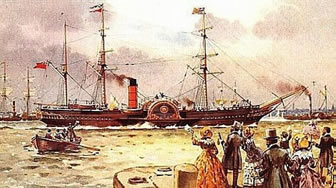
The port of Wilmington during the War Between the States was a vital link that provided
arms, munitions and foodstuffs for the Confederacy. During the WBTS, Wilmington became
the main loading point for government cotton exports and the importation of supplies, despite
the Northern blockade, until the capitulation of Fort Fisher on January 16, 1865.
To illustrate the importance of Wilmington to the Southern war effort and the immense volume
of commercial traffic of its port by 1864, Secretary of War Judah P. Benjamin estimated that
the annualized 1863 exports from the city were $21M, almost five times the total foreign
commerce of the entire State of North Carolina just five years earlier.”
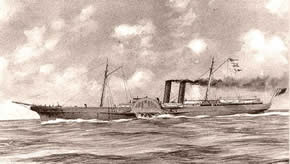
Lincoln attempted to blockade the 3549 statute miles of the Confederate coast with a nearly
non-existent US Navy – an absurdity when one considers the double line shores and numerous
bays and inlets to monitor. The blockade’s ineffectiveness was noted by President Jefferson Davis
in his message to Congress in December 1864, with 43 vessels running into Charleston and
Wilmington, and a loss of only 11 percent of the ships carrying cotton
to Europe from those two busy ports.
Lincoln's Doubtful Blockade
“Some idea of the effectiveness of [Lincoln’s] blockade might be obtained if we could calculate
the munitions of war which came in. The Confederate Army, contrary to tradition, was practically
supplied after 1861, especially the armies of Tennessee and Virginia, by the importation of small arms
from abroad, and the most up-to-date and modern rifles at that, if the report of Major [Caleb] Huse,
the Confederate purchasing agent, and Colonel [Josiah] Gorgas, chief of the Ordnance Department,
can be relied upon.
Altogether, according to the reports of Huse and Gorgas in the Official Records, which have some
gaps, there were about 330,000 stand of small arms, mostly Enfield rifles, with a small sprinkling of
Austrian and Brunswick rifles and revolvers, imported into the east Mississippi region by the
Confederate government. North Carolina, South Carolina, and Georgia, and to a limited extent
Alabama and Florida, imported arms on State account.
The sum total of small arms on private, State and Confederate account for the entire South which
came through the blockade was not less than 600,000 stand. If we assume, as in the case
of the percentage of ships running the blockade, that an average of 1 in 6 was captured,
we have 370 attempted deliveries of munitions and arms, over 300 of which were successful.
Lincoln then, laid down a blockade which, for two years at least, made the old-fashioned English
blockade look like a stone wall in comparison. To gain a doubtful advantage over the Confederacy,
he flew in the face of all American precedents, all American permanent interests and doctrines
of neutral maritime rights, vitiated the principles vitiated in the Declaration of Paris that a blockade
to be binding must be effective, and thereby furnished an interpretation of the Declaration
of Paris for Great Britain which was destined to release that power from the one burdensome
and objectionable feature of that pact.
Over a century of struggle on the part of the weaker maritime powers to force Great Britain
to recognize the rights of neutrals on the high seas was rendered futile, and international
law was put back to where it was in the days of the orders in council and the Milan decrees.
Old Abe sold America’s birthright for a mess of pottage.”
(King Cotton Diplomacy, Foreign Relations of the CSA, pp. 266-267)
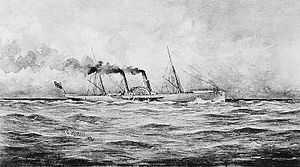
The Effectiveness of the Blockade-Runners
“The operation and organization of the blockade runners, their difficulties and losses, and the tricks
they developed; if the Cambridge Modern History is correct in its allegation that between
October 26,1864 and January 1865 it was still possible for 8,632,000 lbs of meat, 1,507,000 lbs of lead,
1,933,000 lbs of saltpeter, 546,000 pairs of shoes, 316,000 blankets, half a million pounds of coffee,
69,000 rifles, and 43 cannon to run the blockade into the port of Wilmington alone, while cotton
sufficient to pay for these purchases was exported, it is evident that the blockade runners
made an important contribution to the Confederate effort to carry on.”
(The Centennial of the Civil War, Gen. U.S. Grant, III, pp. 49-50)
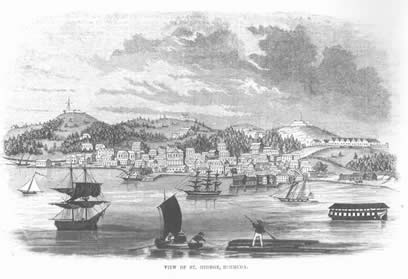
British-Built Blockade Runners
A total of 588 blockade-runners would emerge from English ports during the war; shipping
8,250 cargoes worth two million dollars, the South paid for these imports with 1,250,000 bales
of cotton. The majority of the runners sailed from Liverpool and some from Glasgow. The North
viewed this activity “as virtually tantamount to a participation in the war by the people of Great Britain . . . “
“In the early stages of the war every type of ship was used to break the blockade. But from 1862
onwards only steamers specially built or modified could slip through the Federal screen. Jones,
Quiggin and Company of Liverpool built at least sixteen blockade runners between 1862 and 1865.
The Banshee, Lucy, Wild Dayrell, Bat, Badger, Colonel Lamb, Fox, Georgia, Belle, Hope, Lynx,
Owl, Curlew, Hornet, Plover, Snipe, and Widgeon were all steel or iron paddle steamers of
around 400 tons gross weight and were admirably built to evade the Federal ships.
W.H. Potter and sons in 1864 built two ships of a similar type, the Deer and Dream, while
William C. Miller and Son created not only the Oreto/Florida and the unfortunate Alexandra
but the successful blockade-runners Phantom, Let Her B, Celia, Abigail, and Ray. Bowdler,
Chaffer and Company of Seacombe, in 1864, launched the Secret and the Stag, and, in 1865, the Swan.
The Laird Brothers produced not only the wooden-screw Alabama (the Oreto and the Alexandra
were also wooden-screw steamers), and the steel rams, but five steel paddle-steamers, the Wren,
Lark, Mary, Isabel, and Penguin, and the Robert Todd, an iron screw. All ships were especially suited
to the swift maneuvers essential in blockade-running.
Most of these blockade-runners were bought and run by Liverpool trading firms. Edward
Lawrence and Company, the firm for which Tom Taylor worked as a supercargo throughout the war,
and in which he eventually became a partner, owned the Banshee, a notorious blockade-runner
with at least seven successful round trips to her credit before her capture.
A second Banshee was built and run by Aitken and Mansell and was again managed by the
Liverpool firm. Tom Taylor himself was lauded by Colonel [William] Lamb, commandant of Fort Fisher,
for his “coolness and daring” and his generosity with food and luxuries to the poverty-stricken Confederates.
A number of blockade-runners were owned by the ship builders themselves – who no doubt made
far more profit with them than would have ever been possible through straightforward sales.
William Quiggin of Jones, Quiggin and Company, owned the Bat, the Hope and the Colonel Lamb,
which like the Phantom, roused [US consul to Liverpool Thomas H.] Dudley’s suspicions when it was being built.
The Colonel Lamb was in fact sold by Quiggin to J.B. Lafitte of Nassau, but was never the
property of the Confederacy, although it was one of the most notorious and successful blockade-runners
under Liverpudlian Captain Tom Lockwood. T. Quiggin also owned the Owl, which was sold to Bulloch
for the Confederacy, as were Bat of the same firm and the Deer and the Stag – these were among
the few blockade-runners owned by the Confederacy itself. The Owl was to successfully run the
blockade till the end of the war.
The financial advisor to the Confederacy, Charles Prioleau, of Frazer, Trenholm and Company,
bought several ships for trade with the South. Prioleau also purchased the Flora, the fastest
steamer of her day, and one which was to be a bane to the North.”
(Support for Secession, Lancashire and the American Civil War, Mary Ellison,
University of Chicago Press, 1972, pp. 168-172)
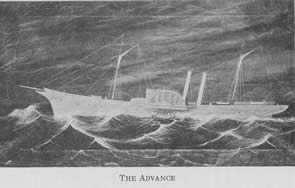
North Carolina had entered the importing business in the later part of 1862,
an idea promoted by Adjutant General James Martin and supported by Governor Zebulon Vance.
The State purchased the “Ad-Vance” for the purpose of blockade running and the ship soon paid
for itself by carrying out cotton bales to Europe and using the profits to bring in millions of dollars’
worth of supplies. Within a year Governor Vance reported to his legislature that he had enough
supplies on hand, along with those obtainable at home, to supply North Carolina’s forces through
1865 even if he did not get another dollar from abroad. The blockade-running business steadily
increased until the fall of Wilmington, and Vance’s prescient decisions endeared him greatly to
the people of his State probably more than any act of his life.
Governor Vance Versus the Confederate Government
“In North Carolina the Confederate government stirred up a hornet’s nest when it attempted to enforce
its contracts with the steamship companies. Governor [Zebulon] Vance flatly refused to allow any
of the steamers in which North Carolina had acquired a share to put on board a bale of Confederate cotton.
Two days after this, January 6, 1864, [Secretary of War James A.] Seddon remonstrated against the
Governor’s obstructiveness, telling him that “the necessities of the government really require adherence
to this regulation,” and that he hoped he would not encourage or allow the infringement of the contract
requiring the shipowners to carry one-third on government account.
The next day the Governor replied that North Carolina had 40,000 blankets, 40,000 pairs of shoes,
large quantities of clothing, leather and other supplies at Bermuda, and that he must have all the
steamers in which North Carolina had an interest to carry these goods. “It is a little remarkable . . . ,”
he said, “that the entire importing operations of this State, which have been so successful . . .
seem to have met with little else than downright opposition rather than encouragement
from the Confederate government . . . “
Then came delays of his ships at Wilmington, and the impressments of his coal by the Confederate
government to furnish the privateers. Now, he said, the climax had been reached in the attempt of
the government to force private blockade runners . . . to carry a third of their cargoes on government
account. He felt sure that the [private blockade-running] companies would stop all their vessels, since
there would be no profit left . . . if the regulations were enforced he would countermand their sailing.
On January 14 [1864] Seddon replied that the steamship companies whom Vance had taken under his
special protection were all foreigners, solely interested in getting as much cotton . . . out of the country in
return for as little service and sacrifice as possible . . .
Soon afterward, on February 17, 1864, the law . . . empowered the President [to regulate] all private
import and export trade, leaving the States free to carry on their own trade in vessels owned entirely
by the State. Immediately . . . all ships going out and coming in must carry one-half
of their cargoes on Confederate account.”
(State Rights in the Confederacy, Frank L. Owsley, Peter Smith, 1961, pp. 133-137)
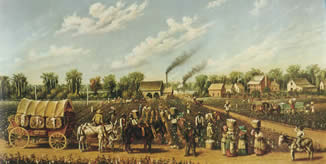
The Northern military goal of depriving the South of black agricultural laborers by capturing,
seizing or killing them, plus the devastation of fields and crops as in the Shenandoah Valley and
Georgia, became ever more effective as the war wore on and Southern territory overrun by
Northern troops. This meant that by the dawn of 1865 Lee’s Army of Northern Virginia was
sustained primarily on what was brought through the blockade at Wilmington.
A primary source for Wilmington, North Carolina blockade running is James Sprunt's
"Chronicles of the Cape Fear," published in 1916 by Edwards and Broughton of Raleigh.
Mr. Sprunt served as purser aboard the blockade runner Lilian, and endured four
years of harrowing incidents and experiences under fire. Several informative excerpts
from his recollections follow.
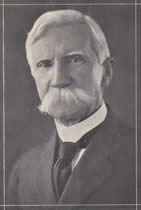
Financial Estimates of Blockade Running
Some idea of the magnitude of the blockade-running interests involving the Cape Fear alone may
be gathered from Badeau’s statement that “in a little more than a year after the capture of Fort Fisher,
the venture’s of British capitalists and speculators with Wilmington alone had amounted to
sixty-six million dollars in gold, and sixty-five million dollars worth
of cotton in gold had been exported in return.”
In the same period 397 steamers had run the blockade at Wilmington. Ridpath says that
the number of prizes of blockade runners made during the four years’ war was 1,504
vessels captured, stranded or destroyed.
Admiral Porter, who directed the naval operations against Fort Fisher, says that a telegraphic
dispatch from General Lee to Colonel Lamb at Fort Fisher was captured, which read as follows:
“If Fort Fisher falls, I shall have to evacuate Richmond.”
The Confederate steamer R.E. Lee, under Captain Wilkinson, ran the blockade at Wilmington
twenty-one times and carried abroad nearly seven thousand bales of cotton, worth at that time
about two million dollars in gold; and she also took into the Confederacy equally valuable cargoes.
Napoleon said that an army moves upon its belly. The resources of the Confederate Army
commissariat, steadily depleted by the drain upon the food producers and by the blockade
of Southern ports, were largely sustained by the successful blockade runners from the
West Indies to Wilmington, whence cargoes of increasing value were immediately
transported to our starving Confederates in the field; but when the multiplied arms
of the new navy, like the deadly tentacles of the octopus, reached into every hiding-place
of these fugitives of the sea, they gradually brought to an end, in the capture of
Fort Fisher, this wonderful epoch in our naval and commercial history.
It was therefore, not the valor of the Federal or of the Confederate forces in the contest at Fort Fisher
that made it most memorable in the history of the war. It was the fatal blow to the Confederate
commissariat, the cutting off of supplies, the starvation of Lee’s army, the closure of the last
hope of the Confederacy, which gives to [Northern] forces at Fort Fisher,
its lasting importance as an historical event.”
(Chronicles of the Cape Fear River, Sprunt, pp. 387-389)
The Blockade
“On the nineteenth of April, 1861, President Lincoln declared by proclamation a military and commercial
blockade of our Southern ports, which was supplemented by the proclamation of the 27th of May to
embrace the whole Atlantic coast from the capes of Virginia to the mouth of the Rio Grande.
This was technically a “constructive” or “paper” blockade, inasmuch as the great powers assembled
in congress at Paris, 1856, removed all uncertainty as to the principles upon which the adjudication
of prize claims must be preceded by declaring that “blockades, in order to be binding, must be
effective; that is to say, must be maintained by a force sufficient really
to prevent access to the enemy’s coast.”
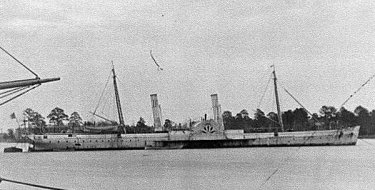
It was obviously impossible at that time for the Federal Government to enforce a blockade
of the Southern coast, measuring 3,549 miles and containing 189 harbors, besides most
innumerable inlets and sounds through which small craft might easily elude the four United States
warships then available for service, the remaining 38 ships of war in
commission being on distant stations.
Measures were, therefore, taken by the Navy Department to close the entrances of most
of the Southern ports, notably those of Charleston and Savannah, by sinking vessels loaded with
stone across the main channels or bars.
The Blockaders:
The first blockader placed upon the Cape Fear Station was one bearing the misnomer Daylight,
which appeared July 20, 1861. Others soon followed, until the number of blockaders off New Inlet
and the Main, or Western, Bar of the river was increased thirty or more; these formed the cordon
every night in the shape of a crescent, the horns of which were so close in shore that it was
almost impossible for a small boat to pass, without discovery. Armed picket barges also
patrolled the bars and sometimes crept close in upon the forts.
For a year or more the fleet was kept upon the blockading stations; then a second cordon was
placed across the track of the blockade runners near the ports of Nassau and the Bermudas,
the cruisers of which sometimes violated the international distance restrictions of one league –
three geographic miles – from neutral land.
At last the third cordon was drawn on the edge of the Gulf Stream, to which the hunted and
harassed blockade runner often became an easy prey in the early morning after a hard
night’s run in the darkness, during which no lights were visible to friend or foe, even the
binnacle lamp being carefully screened, leaving only a small
peephole by which the ship was steered.”
The Cruisers
Some of the later cruisers were faster than the blockade runners and were more dreaded than the
blockading squadron, not only because of their greater speed, but chiefly because of the proximity
of their consorts, which kept them always in sight . . . the prospective division of big prize
[capture] money, running into the millions of dollars, was, of course, the most exciting
feature of the service on the Federal side.
The desertion of Negro slaves from tidewater plantations and their subsequent rescue
as “Intelligent Contrabands” by the coasting cruisers formed an occasional incident in the
records of their official logs; but it is a noteworthy fact, deserving honorable mention, that
comparatively few of the trusted Negroes upon whom the soldiers in the Confederate Army
relied for the protection and support of their families at home were thus found wanting.
A pathetic and fatal instance is recalled in the case of a misguided Negro family which put off from
the shore in the darkness, hoping that they would be picked up by a chance gunboat in the morning.
They were hailed by a cruiser at daylight, but in attempting to board her their frail boat was
swamped, and the father alone was rescued, the mother an all perishing.”
(Chronicles of the Cape Fear River, Sprunt, pp. 389-392)
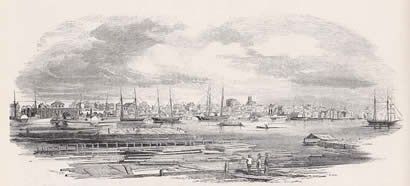
Wilmington – A Port of Refuge
The natural advantages of Wilmington at the time of the War Between the States made it an ideal
port for blockade runners, there being two entrances to the river, New Inlet on the north,
and the Western, or Main, Bar, on the south of Cape Fear.
For miles the slope of our beach is very gradual to deep water. The soundings along the coast are
regular, and the floor of the ocean is remarkably even. A steamer hard pressed by the enemy
could run along the outer edge of the breakers without great risk of grounding; the pursuer, being
usually of deeper draft, was obliged to keep further off shore.
(Chronicles of the Cape Fear River, Sprunt, pg. 392)
The Pilots
The story of their wonderful skill and bravery in the time of the Federal blockade has never
been written, because the survivors are modest men, and because time obliterated from
their memories many incidents of that extraordinary epoch in their history.
Amidst almost impenetrable darkness, without lightship or beacon, the narrow and closely-watched
inlet was felt for with a deep-sea lead as a blind man feels his way along a familiar path, and, even
when the enemy’s fire was raking the wheel-house, the faithful pilot, with steady hand and iron
nerve, safely steered the little fugitive of the sea to her desired haven. It might be said of him as it was
told of the old Nantucket skipper, that he could get his bearings on the darkest night by a “taste” of the lead.
We might recall the names of some of the noted blockade runners and their pilots, so well
known in Smithville [Southport] about fifty years ago:
Cornubia, afterwards called the Lady Davis, C.C. Morse; Giraffe, afterwards known as R.E. Lee, Archibald Guthrie;
Fanny, Henry Howard; Hansa, J.N. Burruss; City of Petersburg, Joseph Bensel; Old Dominion, Richard Dosher;
Alice, Joseph Springs; Margaret and Jessie, Charles W. Craig; Hebe, George W. Burruss; Advance, C.C. Morse;
Pet, T.W. Craig; Atalanta, Thomas M. Thompson; Eugenia, T.W. Newton; Ella and Annie, J.M. Adkins;
Banshee, Thomas Burruss; Venus, R. Sellers; Don, William St. George; Lynx, J.W. Craig;
Let Her Be, J.T. Burruss; Little Hattie, R.S. Grissom; Lilian, Thomas Grissom; North Heath, Julius Dosher;
Let Her Rip, E.T. Burruss; Beauregard, J.W. Potter; Owl, T.B. Garrason; Agnes Fry, Thomas Dyer;
Kate, C.C. Morse; Siren, John Hill; Calypso, C.G. Smith; Ellas, John Savage; Condor, Thomas Brinkman;
Coquette, E.T. Daniels; Mary Celeste, J.W. Anderson; Susan Bierne, Richard Dosher.
Many other steamers might be named, among them the Britannic, Emma, Dee, Antonica, Victory,
Granite City, Stonewall Jackson, Flora, Havelock, Hero, Eagle, Duoro, Thistle, Scotia, Gertrude,
Charleston, Colonel Lamb, Dolphin and Dream, the names of whose pilots may or may not be
among those already recalled. These are noted here because there
is no other record of their exploits extant.”
(Chronicles of the Cape Fear River, Sprunt, pp. 395-396)
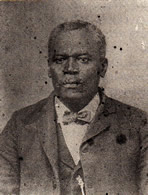
Captain Usina and the Leadsman Without Peer
Born in St. Augustine to Spanish parents, Captain Michael Philip Usina (1840-1903)
enlisted in the Eight Georgia Volunteer Regiment (Oglethorpe Light Infantry) after the outbreak
of war in 1861. Wounded at First Manassas, he joined the Confederate Navy after recovering
and became one the South’s foremost blockade runners. Familiarly known as Mike Usina,
his skill and daring made him famous in Nassau and Bermuda and in all of the Atlantic States.
The [Northern] consul at Nassau, Mr. Whiting, eager for his capture by the cruisers which hovered
near the British islands, bough Usina’s portraits from a local photographer, and sent them broadcast
among the Federal commanders in order to identify him when captured, as many Southerners
escaped long confinement by claiming to be Englishmen. Captain Usina seemed to have a
charmed life, but he was in reality so cool under fire and so resourceful in a tight place or situation,
that he slipped through their fingers frequently when his capture seemed certain.
“The leadsman on board a blockade runner occupied a very responsible position; he had to have great
physical endurance and courage. When shoal water was reached, the safety of the ship and the lives
of all on board depended upon his skill and faithfulness. Were he disposed to be treacherous,
he could, by false soundings, put the ship in the hands of the enemy or run her in the
breakers and endanger the lives of all.
My leadsman was a slave owned by myself. On the last trip of the Atalanta, while under fire, the ship
was going very fast toward shoal water, I thought possibly he might get rattled, and to test him I said:
“Irwin, you can’t get correct soundings, the ship is going too fast, I’ll slow her down for you.”
He answered: “There is no time for to slow down, sir, you let her go, I’ll give you the bottom”; and he did,
he being a leadsman without a peer. I have had him in the chains for hours in cold winter weather,
with the spray flying over him cold enough to freeze the marrow in his bones, the ship often on
shoal water, frequently but a foot to spare under her, and sometimes not that. Yet I never knew
him to make a mistake or give an incorrect cast of the lead.
He is the man to whom, when pointing to the island of New Providence, I said: “Every man on
that island is as free as I am, so will you be when we get there.” He answered: “I did not want
to come here to be free, I could have gone to the Yankees long ago if I had wished.”
And afterwards, when the war was over, I said to him: “I am going to England, perhaps never
to see Savannah again, you had better go home.” His answer was: “I cannot go without you,”
and he did not. The feeling that existed between us can only be understood
by Southern men; by a Northern man, never.”
(Chronicles of the Cape Fear River, Sprunt, pg. 426)
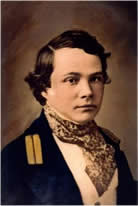
Capt. John Wilkinson
End of a Holy Cause
“Arriving at Nassau on the 8th [of March, 1865], we found many blockade-runners in port, waiting for
news from Charleston; and on the 10th, the Owl returned, after an unsuccessful attempt to enter
Charleston, during which she received a shot through her bows; and intelligence also came of the
capture of the “Stag” and “Charlotte.” On the 23rd, the “Chicora,” which had succeeded in getting
into Charleston, arrived with the fatal news of its evacuation, and the progress of General Sherman
through Georgia and South Carolina.
This sad intelligence put an end to our hopes, and we were now cut off from all communications
with the Confederate Government authorities. We [later] learned that Captain Pembroke Jones, of the
Confederate Navy, was at the time on his way to us via Galveston or Mexico, with orders . . .
to take in cargoes of provisions to a specified point on the Rappahannock Rover, under the protection
of Confederate artillery to be stationed there in readiness. The steamers were to be burned after landing
their cargoes, but Jones could not reach us in time.
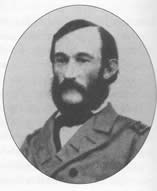
Capt. Pembroke Jones, CSN
We still lingered for later intelligence which was brought by the mail steamer Corsica from New York.
Charleston was evacuated on the 17th of February, and Fort Anderson, the last of the defences
at Wilmington, fell on the 19th. General Johnston had assumed command of the broken remnant
of the army of the Tennessee in North Carolina . . . It was too evident that the end was near.
The speculators in Nassau saw that “the bottom had fallen out,” and all of them were in the depths of despair.
Some of them, it is true, had risen from the desperately hazardous game with large gains, but the majority
had staked their all and lost it; and even the fortunate ones had contracted a thirst for rash ventures,
which eventually led to the pecuniary and social ruin of some of them. Even the Negro stevedores
and laborers bewailed our misfortunes, for they knew that the glory of Nassau had departed forever.
We sailed from Nassau on the 22nd of March and arrived at St. George’s, Bermuda on the 26th.
The harbor was deserted, and the town, in its listless inactivity, presented a striking contrast with its
late stir and bustle. “Twas Greece, but living Greece no more.” After coaling, we took our departure
for Liverpool on the 26th of March, and arrived there on the 9th of April.
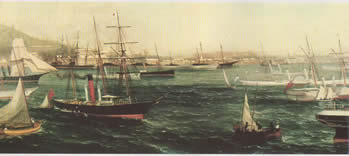
St. George's, Bermuda
The contrast between this happy, peaceful and prosperous country and our own desolated, war-distracted
land, struck a chill to our saddened hearts. The last act in the bloody drama was about to close on that
very day at Appomattox Court house, and before that sun had set, the Confederate
Government had become a thing of the past.
We, who were abroad, were no unprepared for the final catastrophe; for we had learned on our arrival
at Liverpool of General Early’s defeat in the valley of the Shenandoah, and the accession to General
Grant’s already overwhelmingly large forces [concentrating in North Carolina and Virginia] . . . To oppose
these mighty armies, there were 33,000 half starved, ragged heroes in the trenches around
Petersburg, and about 25,000 under General Johnston in North Carolina.
This may not be the place to allude to the fearful penalties inflicted upon a people who fought and suffered
for what they deemed a holy cause. But is should be proclaimed, in the interest of truth and justice, that
the South since the close of the war, has been preyed upon by unprincipled adventurers and renegades
who are determined to rule or ruin. But a brighter day will come.
The end was close at hand. News of the capture of Richmond arrived on the 15th, and a few days
afterwards, intelligence of the surrender of Lee’s army. The Chameleon was soon given up to the
United States Government which claimed the assets, but repudiated the liabilities of the
Confederate Government. Her officers and crew were turned adrift with
“the wide world before them where to choose.”
(Narrative of a Blockade Runner, John Wilkinson, pp. 98-100)
Sources:
Chronicles of the Cape Fear River, 1660-1916, James Sprunt, Edwards & Broughton, 1916
King Cotton Diplomacy, Foreign Relations of the CSA, Frank L. Owsley, University of Chicago Press, 1931
The Centennial of the Civil War, Gen. U.S. Grant, III, NY Historical Association, Volume XLII/ No. 1, January, 1961,
Narrative of a Blockade Runner, John Wilkinson, Valde Books, reprinted 2009 (original 1876)
State Rights in the Confederacy, Frank L. Owsley, Peter Smith, 1961
Copyright 2013, North Carolina War Between the States Sesquicentennial Commission